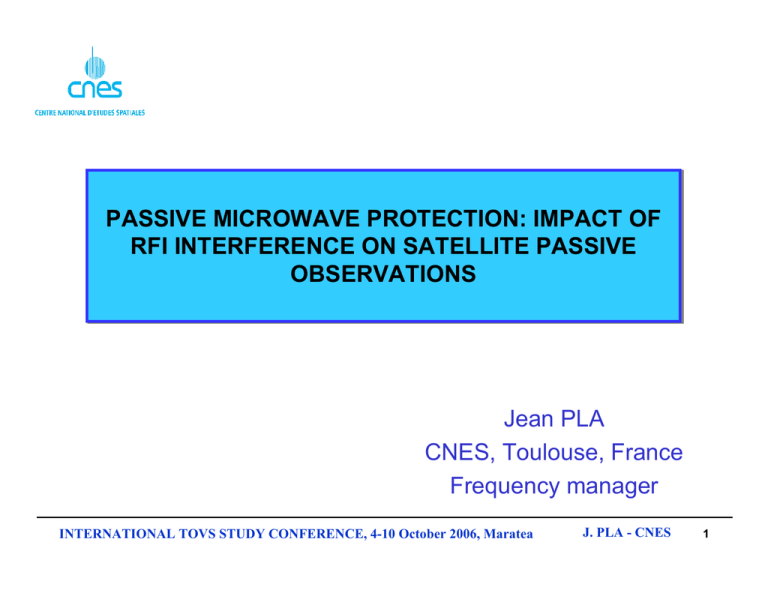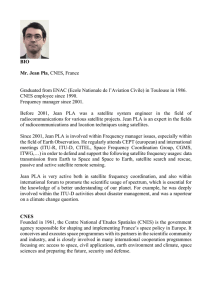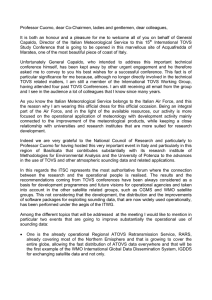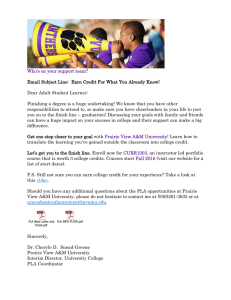PASSIVE MICROWAVE PROTECTION: IMPACT OF RFI INTERFERENCE ON SATELLITE PASSIVE OBSERVATIONS Jean PLA
advertisement

PASSIVE MICROWAVE PROTECTION: IMPACT OF RFI INTERFERENCE ON SATELLITE PASSIVE OBSERVATIONS Jean PLA CNES, Toulouse, France Frequency manager INTERNATIONAL TOVS STUDY CONFERENCE, 4-10 October 2006, Maratea J. PLA - CNES 1 Summary Description of the agenda items 1.2 and 1.20 for the next WRC-2007 Proposed “best” method to solve both agenda items Impact of wrong or missing data Examples of RFI at 6 and 10.6 GHz Conclusion INTERNATIONAL TOVS STUDY CONFERENCE, 4-10 October 2006, Maratea J. PLA - CNES 2 Characteristics of the passive bands: regulatory Two kinds of passive bands XP= primary exclusive 5.340 « All emissions are prohibited in the following bands … » The passive sensors are unable to discriminate between these natural radiations and man-made radiations. Article 5.340 of the RR enables the passive services to deploy and operate their systems Yp = primary passive bands shared with other active services, in general terrestrial services (FS, MS), not space services (MSS, FSS) INTERNATIONAL TOVS STUDY CONFERENCE, 4-10 October 2006, Maratea J. PLA - CNES 3 Objective of the passive bands y1400-1427 MHz: salinity (ocean), soil moisture (ground) y10.6-10.7 MHz: rain, snow, ice, sea state, ocean wind y23.6-24 GHz: total content of water vapour y31.3-31.5 GHz: the lowest cumulated effects due to oxygen and water vapour in the vicinity of the 50 GHz band. Optimum window channel to see the Earth’s surface: reference for the other channels. y36-37 GHz: cloud liquid water, vegetation structure, surface roughness y50.2-50.4 GHz: temperature profile INTERNATIONAL TOVS STUDY CONFERENCE, 4-10 October 2006, Maratea J. PLA - CNES 4 Objective of the passive bands: ITU-R SA. Recommendations SA. 1028 Performance criteria SA.1029 Permissible interference criteria levels for frequency bands P and p y1400-1427P MHz: -174 dBW, 27 MHz, 99.9%, 0.05K y10.6-10.68p, 10.68-10.7P MHz:-156,-166 dBW, 100 MHz, 99.9%, 1/0.1K y23.6-24P GHz: -166 dBW, 200 MHz, 99.99%, 0.05K y31.3-31.5P GHz: -166 dBW, 200 MHz, 99.99%, 0.05K y36-37p GHz: -166 dBW, 100 MHz, 99.9%, 1/0.1K y50.2-50.4P GHz: -166 dBW, 200 MHz, 99.99%, 0.05K y52.6-54.25P GHz: -169 dBW, 100 MHz, 99.99%, 0.05K INTERNATIONAL TOVS STUDY CONFERENCE, 4-10 October 2006, Maratea J. PLA - CNES 5 Objective of the passive bands: Data availability Data availability is the percentage of area or time for which accurate data is available for a specified sensor measurement area or sensor measurement time. For a 99.99% data availability, the measurement area is a square on the Earth of 2,000,000 km2, unless otherwise justified. For a 99.9% data availability, the measurement area is a square on the Earth of 10,000,000 km2 unless otherwise justified. For a 99% data availability the measurement time is 24 hours, unless otherwise justified. INTERNATIONAL TOVS STUDY CONFERENCE, 4-10 October 2006, Maratea J. PLA - CNES 6 Agenda item 1.2 of WRC-07 • to invite ITU-R to conduct sharing analyses between the EESS (passive) and the SRS (passive) on one hand and the fixed and mobile services on the other hand in the band 10.610.68 GHz to determine appropriate sharing criteria • to invite ITU-R to conduct sharing studies between the passive services and the fixed and mobile services in the band 36-37 GHz in order to define appropriate sharing criteria INTERNATIONAL TOVS STUDY CONFERENCE, 4-10 October 2006, Maratea J. PLA - CNES 7 Agenda item 1.2 of WRC-07 • For the bands 10.6-10.68 GHz and 36-37 GHz, the corresponding radiometers are all conical scan (rotating). Geomet ry of conically scanned microwave radiomet er Conical scan around nadir direct ion IFOV Incidence rack Sat ellit e subt Pixel Useful scan-angle Useful swat h INTERNATIONAL TOVS STUDY CONFERENCE, 4-10 October 2006, Maratea J. PLA - CNES 8 Agenda item 1.2 of WRC-07 • • For both bands 10.6-10.68 GHz and 36-37 GHz, dynamic simulations are conducted for specific passive sensors (AMSR-E, AMSR, CMIS, MADRAS) and for typical deployments of terrestrial systems. Example of a dynamic simulation 2 10 1 Corresponding cumulative % 10 0 10 -1 10 -2 10 -3 10 -220 -210 -200 -190 -180 -170 Received power at the radiometer -160 -150 INTERNATIONAL TOVS STUDY CONFERENCE, 4-10 October 2006, Maratea J. PLA - CNES 9 Agenda item 1.2 of WRC-07 • • The received power are compared to the thresholds contained in Recommendation SA.1029-2 according to a cumulative corresponding % of 0.1 for a limited area of 10000000 km2 Proposed methodology in the Conference preparatory text: development of sharing criteria based on single entry emission limits to be included in a footnote of Article 5 of the Radio Regulations. Those limits are suggested to be non-retroactive for terrestrial active systems brought into use before WRC-07. INTERNATIONAL TOVS STUDY CONFERENCE, 4-10 October 2006, Maratea J. PLA - CNES 10 Agenda item 1.2 of WRC-07: examples of RFI at 10.6 GHz INTERNATIONAL TOVS STUDY CONFERENCE, 4-10 October 2006, Maratea J. PLA - CNES 11 Agenda item 1.2 of WRC-07: impact of RFI at 10.6 GHz, lack of data Same areas of the world are corrupted by man made RFI in the band 10.6-10.68 GHz. It means that some areas of the world will suffer from a lack of data, since it is acknowledged that those corresponding data are totally unusable, taking into account the existing high level of interference. The question is: what is the impact of this lack of data on the overall output products if some data are systematically excluded on the same geographic areas? Are the output data still acceptable or reliable? INTERNATIONAL TOVS STUDY CONFERENCE, 4-10 October 2006, Maratea J. PLA - CNES 12 Agenda item 1.20 of WRC-07 • to consider the results of studies, and proposal for regulatory measures, if appropriate, regarding the protection of the Earth exploration-satellite service (passive) from unwanted emissions of active services in accordance with Resolution 738 (WRC-03) INTERNATIONAL TOVS STUDY CONFERENCE, 4-10 October 2006, Maratea J. PLA - CNES 13 Agenda item 1.20 of WRC-07 Bande attribuée au SETS (passive) Bande attribuée à un service actif Service actif 1 400-1 427 MHz 1 350-1 400 MHz Service fixe (SF), service mobile (SM) et service de radiolocalisation (RL) 1 400-1 427 MHz 1 427-1 429 MHz SF, SM (sauf mobile aéronautique) et service de recherche spatiale (Terre vers espace) 1 400-1 427 MHz 1 429-1 452 MHz SF et SM 23,6-24 GHz 22,55-23,55 GHz Service inter-satellites 31,3-31,5 GHz 30-31 GHz SFS (Terre vers espace) 50,2-50,4 GHz1 50,4-51,4 GHz1 SFS (Terre vers espace)1 50,2-50,4 GHz1 47,2-50,2 GHz (Régions 2 et 3) 49,44-50,2 GHz1 (Région 1) SFS1 1 LES ÉTUDES RELATIVES À CETTE BANDE DOIVENT TENIR COMPTE DU NUMÉRO 5.340.1 DU RÈGLEMENT DES RADIOCOMMUNICATIONS. INTERNATIONAL TOVS STUDY CONFERENCE, 4-10 October 2006, Maratea J. PLA - CNES 14 Agenda item 1.20 of WRC-07: unwanted emission problem • The boundary between the out-of-band and spurious domains occurs at frequencies that are indicated in Figure 1: in general, the boundary, on either side of the centre frequency of the emission, occurs at a separation of 250% of the necessary bandwidth, or at 2.5 BN. FIGURE 1 Out-of-band and spurious domains Unwanted emissions Spurious domain Unwanted emissions Necessary bandwidth Out-of-band domain Out-of-band domain Spurious domain Frequency of the emission Limits of the necessary bandwidth Boundary of the spurious domain INTERNATIONAL TOVS STUDY CONFERENCE, 4-10 October 2006, Maratea J. PLA - CNES 15 SATELLITES FOR THE BANDS 24, 31, 50 GHZ ORBITAL CONFIGURATION OF PUSH-BROOM PASSIVE SOUNDER Cold calibration: 83° re.nadir 90° re.orbit plane EESS orbit 850 km alt. IFOV: 1.1° Field of view: Cross-track, +/- 50° re.nadir 50° 83° re.nadir 50° Swath width 2300 km Sub-orbital track Nadir direction INTERNATIONAL TOVS STUDY CONFERENCE, 4-10 October 2006, Maratea J. PLA - CNES 16 Agenda item 1.20 of WRC-07: representation of unwanted emission spectra • • • Use of RR No. 1.153 the unwanted emission power in the passive band to be no greater than 0.5% of the total mean power of the emission (23 dB attenuation). Recommendation ITU-R SM.1541 provides a worst-case analysis in which the OOB emissions from the active service are overstated. Usage of more realistic methodologies – Modulation filtering: DVB-S standard (40 dB attenuation) or usage of more traditional waveforms (20 dB attenuation) such as ⎛⎜ sin πfT ⎞⎟ 2 ⎜ πfT ⎟ ⎝ ⎠ – Post-modulation filtering in most cases: between 25 and 40 dB attenuation • Total expected attenuation (depending on bandwidth of the active service) within the adjacent passive band: between 23 and 80 dB. INTERNATIONAL TOVS STUDY CONFERENCE, 4-10 October 2006, Maratea J. PLA - CNES 17 Agenda item 1.20 of WRC-07: dynamic simulations, methodologies Like agenda item 1.2, dynamic simulations are conducted in a co-frequency mode. How much is the interference threshold exceeded according to ITU-R Recommendations? The bandwidth scaling factor compares the necessary bandwidth Bn of the active service to the EESS (passive) bandwidth Bp. Attenuation provided by Recommendation ITU-R SM.1541 or other modulation/ post-modulation filtering (see before). INTERNATIONAL TOVS STUDY CONFERENCE, 4-10 October 2006, Maratea J. PLA - CNES 18 Method to solve the agenda item 1.20 of WRC-07 Proposed methodology in the Conference preparatory text: development of a single entry emission limit for each corresponding active service within the EESS (passive) band to be included in a footnote of Article 5 of the Radio Regulations. Those limits are suggested to be non-retroactive for active systems brought into use before WRC-07. INTERNATIONAL TOVS STUDY CONFERENCE, 4-10 October 2006, Maratea J. PLA - CNES 19 Agenda item 1.20 of WRC-07, impact of RFI at 1.4 GHz (simulation SMOS type) (1/2) Input brightness temperature map depicting a segment of the Yellow River near Xi'an, a city located in the north-west of China INTERNATIONAL TOVS STUDY CONFERENCE, 4-10 October 2006, Maratea J. PLA - CNES 20 Agenda item 1.20 of WRC-07, impact of RFI at 1.4 GHz (simulation SMOS type) (2/2) Reconstructed brightness temperature map with RFI using an average level of -10 dBW INTERNATIONAL TOVS STUDY CONFERENCE, 4-10 October 2006, Maratea J. PLA - CNES 21 CONCLUSION (1/3) • • IMPACT OF HIGH LEVEL OF INTERFERENCE Lack of data what is the impact of this lack of data on the overall output products if some data are systematically excluded on the same geographic areas? Are the output data still acceptable or reliable? IMPACT OF UNDETECTABLE LEVEL OF INTERFERENCE This is a situation that is more than likely to occur over large areas. It would imply that corrupted data will be actually used within NWP (Numerical Weather Prediction) models or other models making usage of both data derived from satellite and terrestrial observation. In that case, the data are actually used within the model because the data were initially known to be acceptable (or assumed to be derived from natural emission only). What happens on the weather forecast (or other similar output products) if, for example, some EESS satellite pixels are corrupted with wrong data due to non-natural emissions at 24 or 50 GHz? INTERNATIONAL TOVS STUDY CONFERENCE, 4-10 October 2006, Maratea J. PLA - CNES 22 CONCLUSION (2/3) • Method able to adequately protect the corresponding passive bands proposes hard limits (in-band ou outof band): may constrain the existing or future systems in operation in those bands. Some operators already explained the quantitative consequences of a possible limitation of the power of the fixed links. • The ITU-R working party in charge of the passive sensors already provides a qualitative explanation of the consequences of various levels of aggregate interference received by a passive sensor. INTERNATIONAL TOVS STUDY CONFERENCE, 4-10 October 2006, Maratea J. PLA - CNES 23 CONCLUSION (3/3) • Urgent matter to get a quantitative explanation of those various levels of degradation. It is still possible to keep arguing that it is not so obvious to derive this kind of information since complex algorithms are needed to model the atmosphere which is known to be very unstable by nature. It is true that it is hard to distinguish between weak radio frequency interference and naturally geophysical variability. • Space and meteorological agencies have to bring evidence that interference exceeding the interference quoted in RS.1029-2 will disrupt the existing or planned algorithms. INTERNATIONAL TOVS STUDY CONFERENCE, 4-10 October 2006, Maratea J. PLA - CNES 24



